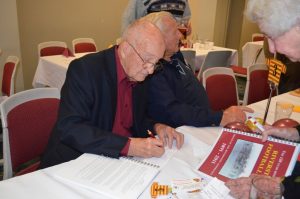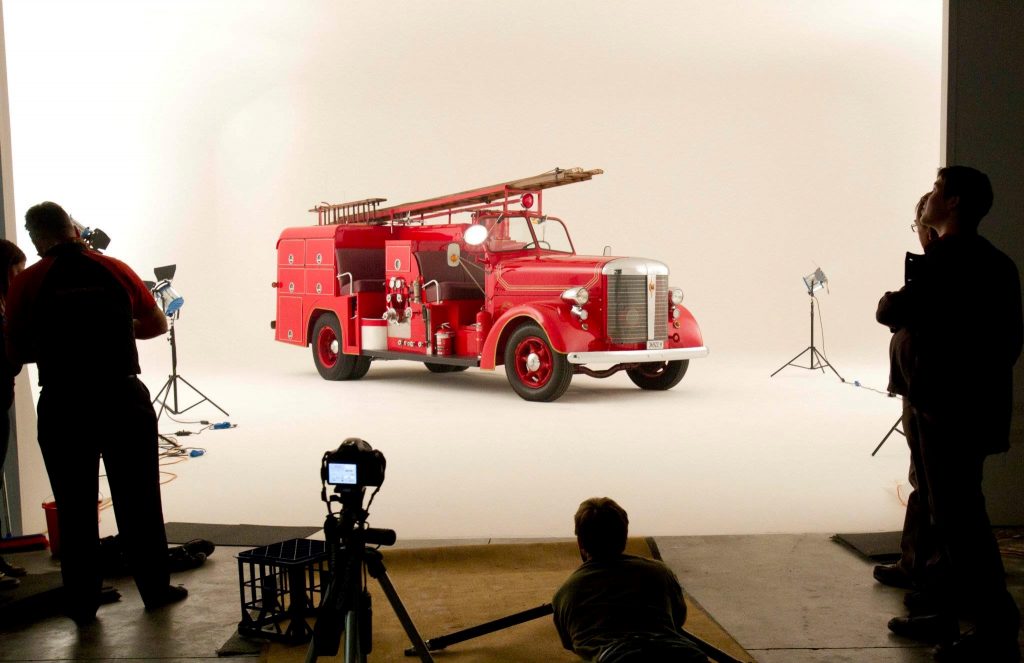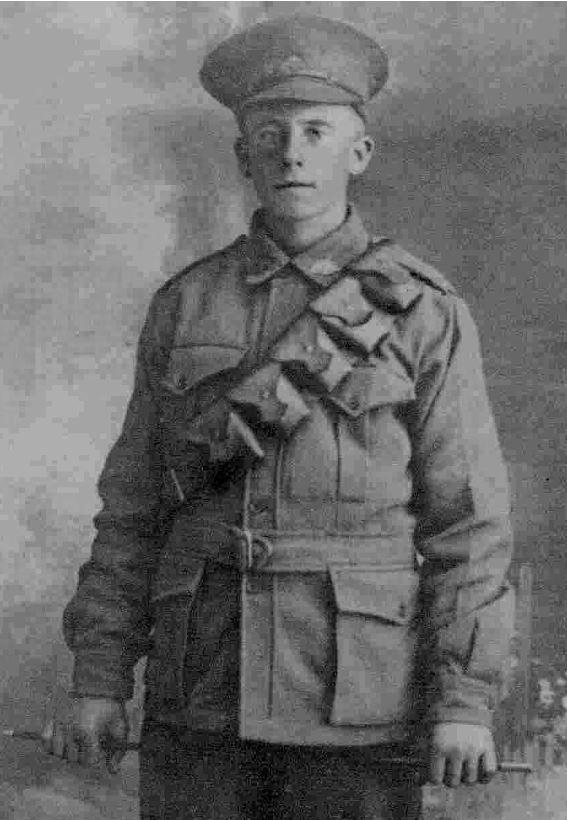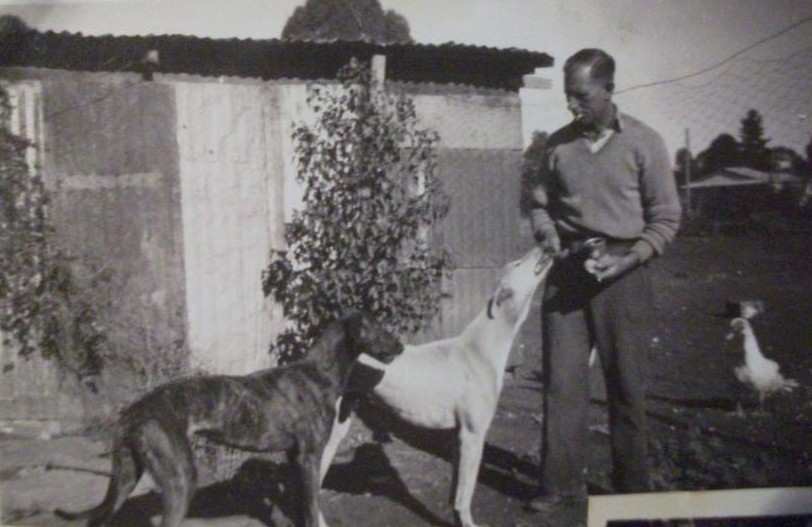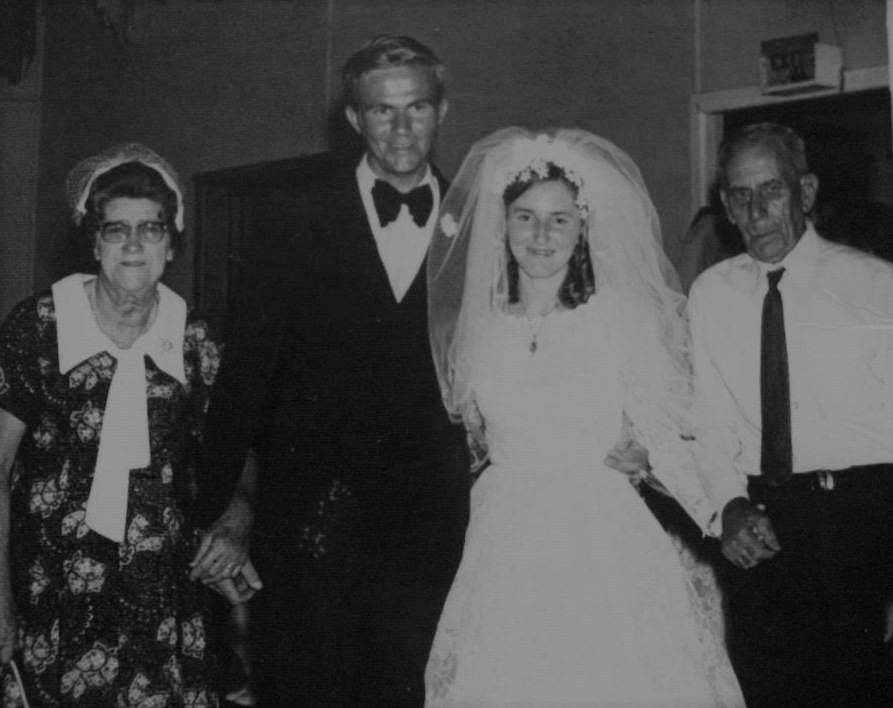by Clarrie Neal / Judith Lewis
Foreword: The Historical Society has over 160 booklets, housed at the Museum, that tell about people, places and events associated with the Riverstone District’s history. Many of these booklets have been compiled by Clarrie Neal, the Society’s Vice-President. Clarrie has written his own life story, which may be read at the Museum. This is a condensed version of that most interesting story.
Clarrie was born on 3rd May, 1935 at Oxford Street, Riverstone. His father, a French Polisher who completed his apprenticeship in 1930, had been unable to get work in his trade due to the Great Depression. Clarrie Snr. found work on the mutton board at Riverstone. After a year of travelling from Bexley to Riverstone, leaving home at 4:00am, Clarrie Snr. and his wife, Alice (nee Holden), made the move to Riverstone in 1933. Their first permanent home was at 29 Crown Road where they lived till c1944. By then the family had saved enough money to put a deposit on a home on a double block of land at 13 Brisbane Street, purchased from Ron Allen for £150.
Clarrie’s brother, Ron, was born on 23rd March 1937. The two boys have shared a great brotherly relationship all their lives. Although they now live many kilometres apart, Clarrie at Baulkham Hills and Ron at Orange, they still manage to share quality time together.
Clarrie attended Riverstone Public School between 1940 and 1946 (no Kindergarten in those days) and did his secondary schooling at Homebush Boys’ High School. Clarrie’s memories of schooldays in the war years at Riverstone are a story in itself: – going to school everyday of those six years barefooted, as did most boys, wearing hand-me-down clothes, everyone did, popular Headmaster, Joe Millerd, and his stories of WWI, equally popular Deputy, Jim Russell, a first grade cricketer with Cumberland, who would put a penny or a threepence on the stumps as a reward for getting him out (rarely collected), teachers Mrs Foreman and Mrs Webster learning that their husbands would not be returning from active service, Air Raid trenches being built in the school grounds.
Clarrie recalls home and town life then being so different to todays: – rationing, because of shortages caused by the war, meaning families being issued with coupons to buy food and clothing, no self-service stores, no cash registers, plastic containers, bottles or bags, no shopping trolleys, Coca Cola or fruit juices, no refrigerators, freezers or display cabinets, no ice cream, baby food, snack foods, take-aways or pre-packaged meals, pet foods, disposable nappies and very few health or beauty products. “Rinso” and “Persil” were the only soap powders, “Sunlight” and “Velvet” the only soaps.
Grocery orders were delivered on a weekly basis with mothers leaving the order at the store early in the week for it to be delivered at week’s end. If mothers weren’t home the grocer would leave the box on the kitchen table and put any perishables such as cheese or butter in the icebox. Houses were rarely locked in those days! Accounts would be hand written and totalled manually and a small bag of boiled lollies would be left for the kids! Milk was delivered daily, usually by horse and cart, taken from a tank in the cart and poured into a billycan left in a box on the front fence. Bread was delivered five days a week, also by horse and cart, and brought to the door by the baker or left in the fence box if no one was home. Milko’s and Baker’s horses were so familiar with their rounds that they would stop at each house, when served they would move on to the next, even if it was around the corner.
Leisure activities were many – building and riding in four-wheeled billycarts; playing tennis, using racquets with broken strings, on a “court” marked out on the dirt road; cricket was played on a “pitch” marked out in a nearby paddock using a bat made from a sturdy piece of wood and any type of ball available. The Neal pitch was marked out in the paddocks behind their house. Norm Jennings (Hamilton Street), Ron Shields (King Street) and Matt Johnston (Mill Street) also had “pitches” in paddocks near their homes. (I recall a cricket “match” played in Matt’s paddock between boys from Rivo and Rosehill. Matt’s uncle and aunt, Matt and Dorrie Johnston, who had moved to Rosehill from their Elizabeth Street home, organised the Rosehill Team. Bill Shepherd, my older brother, played for Rivo. I helped in the Johnston kitchen with the making of sandwiches for lunch).
For football, bush poles were erected to make goal posts to practice kicking. Old footballs, no matter how dilapidated, were filled with stuffing so they could continue to be used. Playing with the Shields’ they used a ball made from a pig’s bladder. Many were the times when Ron would fall on a ball, causing it to burst, hence the cry, “Mr Shields, can you get us a new pig’s bladder?”
The Vineyard bush and the Meatworks’ paddocks (not allowed, but still utilised) were the boys’ playgrounds. Clarrie’s schoolmates included Charlie Weaver, Reggie (Googa) Anderson, Ted (Tont) Tuckwell, Norm (Steamer) Jennings, Neville Stockwell, Bobby Parkes and Dessie Cartwright . The Meatworks’ paddocks were great places for collecting mushrooms after rain, for fishing in the creeks, for playing in one of the dumps. Sometimes the boat kept in the creeks to clear debris and weeds would be “borrowed”.
Most boys made their own catapults, which they took into the bush to shoot at bottles, tins and birds. A favourite hobby was saving birds’ eggs. The eggs were collected from nests, a hole was pierced in each end and the yolk was blown out. Reggie was the best tree climber and had the best collection. That was how he earned the nickname “Googa”. As a bird lover today, Clarrie now regrets these activities. Their main swimming hole was a pool on Chain of Ponds Creek (known as Andrews or Andy’s) at the end of Crown Road. There was a smaller swimming hole in the Vineyard bush between Loftus Street and Crown Road.
Family holidays today often involve a visit to the theme parks on the Gold Coast, or a flight to Disneyland, or a stay on a resort island. The Neal family holidays in the 40s meant a walk to catch the 5:20am steam train to Parramatta, an electric train to Lidcombe, another electric train to Bankstown, a bus ride to Revesby, then a two kilometre walk to the Georges River, a “cooee” to Uncle Bill (Clarrie Snr’s brother) who had a shack on the other side of the river, at Mickeys Point between Lugarno and Picnic Point. Sometimes Uncle Bill would need to make two trips across in his rowing boat and it was often mid-morning before they would be settled. All this, whilst carrying enough clothing and foodstuffs to last for the whole holiday. Sometimes their friends, Dolly and Jack Douglass, and their two boys Dessie and Barry, accompanied them. Weekends were also sometimes spent there. Clarrie recalls, “They were the best holidays one could ever wish for and I still love going fishing there.”
Secondary schooling was a shock out of his comfort zone for Clarrie. From having 30 great friends at Riverstone, always coming in the top three in class, he went to being on his own with 160 other First Year boys and coming 130th in the yearly exams AND he had to wear shoes! He settled down in Years 2 and 3 and, when he completed his Intermediate Certificate, he came 50th.
Clarrie’s working life began in 1950 as the office boy at the Meatworks. After a few weeks he was offered the job as brand boy on the Mutton Board where he was employed by the State Department of Agriculture with the opportunity to become a Meat Inspector. A good salary of £4 per week saw him buy a new Alban bicycle from Denny Mason. Now he had his own transport to ride to tennis, cricket, the pictures, fishing or along his favourite bush tracks.
Sports which Clarrie played in his adult life included cricket, tennis, golf and squash. He remembers well his first game of competition tennis. With Charlie Weaver, Neville Stockwell and brother Ron, all of them young boys in short pants, they played a team of much older men at Blacktown. After a seesawing match they were level at the end of the eighth set and won the last set 6-5 to win by one game. His first game of golf was not so successful. On the old Braeside Course at Rouse Hill, he lined up at the first hole, had an estimated 15 air swings before making contact with the ball. The more swings he had, the more the spectators giggled and the smaller he felt. On the 7th tee he lined up and hit a “beauty”. The ball soared down the fairway with the head of the club and some loose binding trailing about a metre behind it! He then had to explain to the manager what had happened to one of his hire clubs!
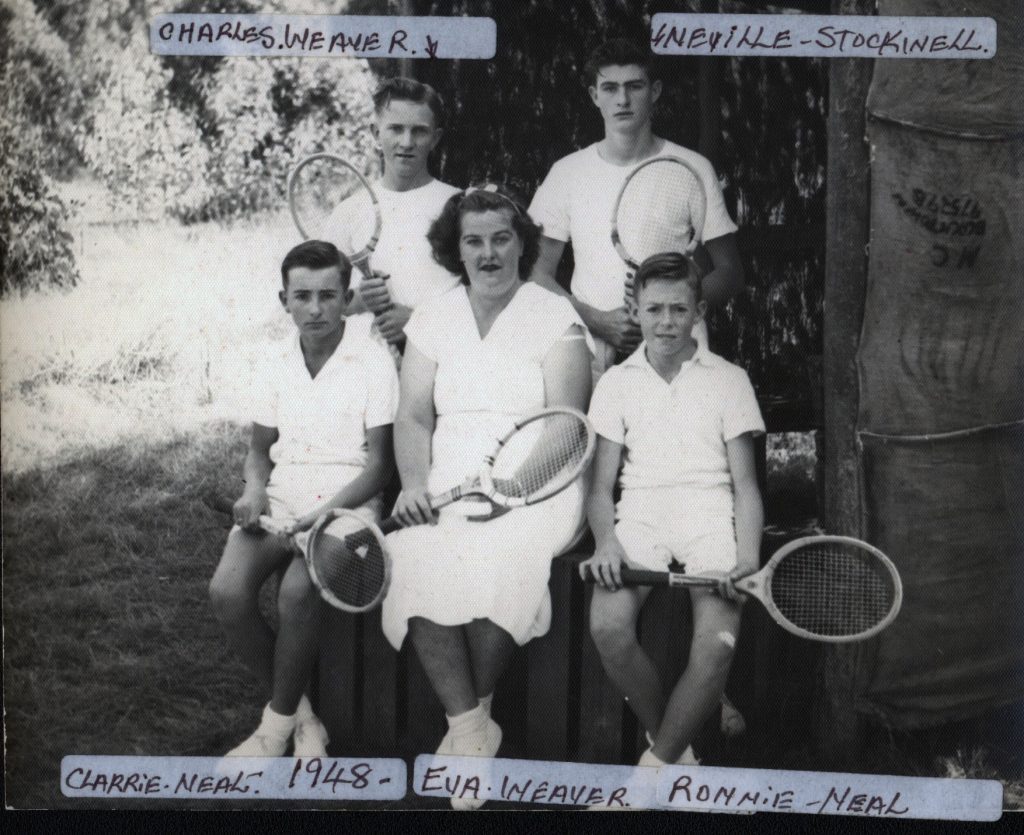
Night trots began at Harold Park in 1950. Neville Stockwell’s father, Dick, owned trotters so they hardly ever missed a meeting. Often a bus, loaded with patrons, would run from Riverstone. They also regularly attended gymkhanas and the Saturday afternoon meetings at Londonderry. With no television many nights were spent playing cards –poker, euchre, five hundred, pontoon, solo and several variations of rummy. When the Goddard family, Alick, Nita and Jan, became their neighbours in Brisbane Street they would play cards three and four nights a week.
After gaining his Meat Inspector’s certificate Clarrie commenced duties at Homebush in September 1955. After three months training he was transferred to Orange where he lived at the Victoria Hotel in the main street, at the railway crossing. The Ryans looked after him well and, with his sporting interests, he soon made many new friends, some of whom he still corresponds with today. He returned to Sydney in March 1959 and later that year, at a dance at Strathfield, he met Beverley Bennett. They became engaged on Bev’s 20th birthday, 5th October 1960. They bought the land at Baulkham Hills for £1,200 and began building their brick home, doing much of the work themselves. Costing under £5,000 the house was ready to move into when they married on 5th August 1961.
After only eight months in their new, modern home Clarrie was transferred to Wingham where accommodation was scarce. Bev, a city girl, went from this to living in half of a very old house with shared amenities. She handled the change well. Dances, balls and tennis allowed them to make many new friends and they look back on many fond memories of Wingham. Other towns in NSW where Clarrie worked were to include Wallangarra, Tenterfield, Wagga, Bourke (twice), Goulburn, Cootamundra, Berrima, Canberra, Gosford, Guyra, Casino, Blayney, Condobolin and Yallah.
Clarrie and Bev’s first child, a son, Lewis, was born prematurely on 1st July 1963. He weighed an estimated 2lbs and spent the first three months of his life in a humidicrib. They brought him home on the day he was expected to be born, 24th September, Their daughter, Linda, arrived four years later, on 20th June 1967 after a normal birth and weighing 8lbs. The purchase of a caravan in 1972 enabled Bev, Lewis and Linda to join Clarrie during school breaks when he was working away from home. The ’van also enabled the family to have many great annual holidays, at places like Long Jetty, Port Macquarie and Forster. Clarrie completed a Health Inspector’s Course by correspondence in 1971 but decided not to pursue the job change as the trips away had become less frequent and the future looked better for them in Sydney. A staunch supporter of the trade union Clarrie was, for many years, the secretary of the Riverstone branch of the Meat Inspectors’ Association.
1965 was a year of severe drought and the year Clarrie was transferred to Bourke. Bev stayed home with Lewis. First impressions of Bourke were not good but once he joined the tennis and golf clubs things changed. His roommate at Bourke was a Canadian, Dave Finnimore, and the pair still keep in touch. In 1988 Clarrie and Bev spent three weeks with Dave and his wife visiting Canada’s Rocky Mountains. Clarrie was to return to Bourke several times, once for work and other times because his family asked to go there. When he enquired why they replied, “Because you are always talking about it”.
In 1969 Clarrie was seconded to the Department of Health for six months to replace the Inspector at Canberra’s abattoirs. Conditions at the abattoirs had become the subject of a Senate Select Committee Inquiry. The Department of Health owned the abattoirs and had allowed it to become very run down. They sold the plant to a private operator for a quarter of its real value. The new owner asked Clarrie to bring it up to an acceptable standard. He enjoyed the task. The inquiry attracted a lot of media attention. It found the Department of Health had been neglectful with its management and that it had sold the plant at less than its market value.
1981 saw Clarrie enjoying a “wonderful” three weeks’ experience working on a voluntary project with the Rotary Club on a community centre at Leitre, five Protestants on a Catholic Mission, followed by a community hospital at Ileg, both in Papua New Guinea. The native children were always happy and willing to help. Clarrie had been told the children would be amazed by his false teeth. Five boys were helping him when he decided to give them something to laugh at and, with a little flap of his arms, he let his teeth come out. The boys were hysterical with laughter and the next afternoon, after school, they were back, along with all the village children, all flapping their arms for a repeat performance. The downside to the trip was that eight months later Clarrie was stricken with malaria. Fortunately he had no further attacks.
In 1983 Riverstone Public School celebrated its centenary. Clarrie contacted a few mates and booked for a table of 15 for the planned Dinner Dance. As word spread 15 soon became 85. Amongst that number was former Deputy Headmaster, Jim Russell. This was the forerunner of the School Reunions Clarrie has organised on a regular basis, roughly every three years, since then. The 1996 Reunion marked 50 years for his 6th Class of 1946 and 120 were in attendance. There were 180 in 1999, 220 in 2002 and for Riverstone’s Bicentenary Year 2010 there were 162. People travel from all over Australia to attend the Reunions. Clarrie rightly surmises that “Riverstone was a small, close-knit community, times were tough, people did care and were always willing to help”.
Also in the 1980s Clarrie decided to change to the Training Section, which meant leaving the Riverstone Meatworks to work in the city. He spent several years training new and old inspectors throughout NSW on new procedures. In 1990 he became Inspector in Charge of Staff Resources responsible for some 500 meat inspectors throughout NSW.
Clarrie retired in 1995. He was made aware of a pile of old photos stored in the Meatworks’ (now closed) office. Roadmaster’s John Robinson gave Clarrie the photos on the understanding that they were to be given to the Historical Society for safekeeping. After cleaning and sorting the photos and repairing the frames Clarrie did as he had promised and the Society welcomed both him and Bev. So began his interest in the early days of Riverstone and his mission to record a way of life that was rapidly disappearing. He has spent countless hours talking with descendants of old Riverstone families recording their stories and memories. Having worked for so many years at the Meatworks meant Clarrie was known to most of the people he interviewed but it is his friendly approach and manner that have made so many people “open up” to him and has given the Historical Society such a wonderful collection of local history.
As well as their work with the Riverstone & District Historical Society, Clarrie and Bev are active members of The Hills District Historical Society and Castle Hill Probus Club, with whom they enjoy many holidays. Their son Lewis married Linda Potent and they have two boys, Lachlan and Carl and a daughter, Grace. Linda married Graham Daniels and they have two children, Rebecca and Jacob. The Daniels’ family live in Queanbeyan, so Clarrie and Bev spend time with them when possible. Lewis and his family live closer, at Pennant Hills. Clarrie and Bev are delighted with their family and “the pleasure they bring to us when we have the opportunity to be with them”.
The Riverstone & District Historical Society is similarly delighted that the Neals, Clarrie and Bev, are such an integral part of our organisation. As a token of appreciation from the Members, and in recognition of his years of work documenting the oral and photographic history of the Riverstone District the Historical Society, on 24th June 2007, appointed Clarrie its first Life Member.
